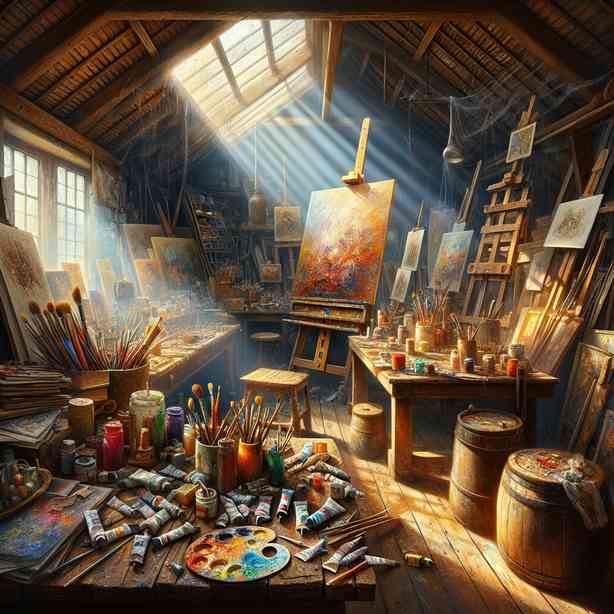
The studio, often regarded simply as a workspace, transcends ordinary definitions when infused with creativity and purpose. It becomes a sanctuary for artists, a space where inspiration flourishes and ideas are born. In this piece, we will explore the enchanting world of a messy studio that, despite its chaotic appearance, truly feels sacred to its creator.
A studio is more than just a physical location; it is a reflection of the artist’s journey, a repository of thoughts, emotions, and experiences manifested in tangible form. Picture an environment filled with vibrant hues, abstract shapes, and half-finished projects scattered about. This seeming disorder is not simply a consequence of artistic chaos but rather a pivotal part of the creative process. Each paint splatter, each misplaced tool, contributes to a narrative that is uniquely tied to the artist’s evolution.
The initial step in understanding this concept is to recognize the emotional connections that form within these walls. Every item in a studio has a story, a memory linked to the moment of its creation or the time it inspired a breakthrough. The paintbrush that feels comfortable in the artist’s hand might have been part of a transformative experience, making it a cherished tool rather than just an instrument. Hence, the messiness becomes a visual documentation of an artist’s journey, a testament to their dedication and passion.
The creativity that thrives in such environments often stems from the freedom associated with imperfection. A messy studio can liberate the mind, allowing for unrestrained exploration and experimentation. Clutter often fosters a unique perspective, encouraging artists to see beyond conventional boundaries. This liberated mindset nurtures innovation; it allows for mistakes to come alive as opportunities for creative growth. In this way, what might appear as disarray can actually be a rich source of inspiration.
The role of sensory experiences in this context cannot be understated. The scent of paint, the texture of canvas, and the sight of bright colors all conspire to create an atmosphere that feels almost sacred. When an artist enters their studio, they do not merely step into a workspace; they enter a realm of possibility, where the physical and spiritual intertwine. The very act of creating becomes a ritual, one that is deeply personal and profoundly meaningful.
Furthermore, there is a distinct energy that encapsulates a messy studio. This energy is often described as electric, a palpable force that encourages risk-taking and vulnerability. Artists harness this energy to delve deeper into their subconscious, allowing their intuition to guide their hands. The studio becomes a place where the line between reality and imagination blurs, facilitating extraordinary artistic outcomes.
The symbolism of messiness is an essential part of recognizing the sacredness of such spaces. In our orderly world, mess is often met with resistance; it’s viewed as a failure to maintain control. However, in an artist’s studio, it tells a different story. The tangles of paint tubes and stacks of unfinished works represent exploration, failure, and growth. They remind both the artist and the observer that the journey of creativity is not linear but rather a spiral filled with twists, turns, and unexpected revelations.
As we consider the sacred nature of a messy studio, it’s essential to appreciate the community that surrounds it. Many artists thrive in collaboration, feeding off the energy and feedback of fellow creators. In these shared spaces, the messy studio becomes a hub of collective thought and inspiration. Conversations flow as freely as paint from a brush, leading to partnerships that can transform individual visions into collaborative masterpieces. The community aspects enhance the sense of sanctity, as artists support one another on their unique creative paths.
Moreover, within this creative chaos lies a profound lesson about acceptance. Embracing mess means accepting that not everything will lead to immediate success; there will be failures and setbacks along the way. But rather than being discouraged, this acceptance of imperfection allows artists to continue expressing themselves authentically. It teaches resilience, encouraging them to persist and refine their skills, ultimately leading to greater personal satisfaction and artistic fulfillment.
The messy studio also serves as a canvas of evolution. As artists grow, both personally and professionally, their studio reflects this. What was once a space filled with clumsy attempts at mastering a skill may transform into a haven of polished works and refined techniques. Yet, the mess remains—a reminder of where they began, the struggles they overcame, and the experience they gained. The studio, therefore, becomes a living testament to their artistic identity, celebrating every stage of their creative journey.
As we draw our exploration of the messy studio that feels sacred to a close, it is worth reflecting on the importance of personal spaces dedicated to creation. The significance of a studio extends beyond the individual; it can inspire others, spur conversations about art and creativity, and foster connections in a broader artistic community. Recognizing the beauty within chaos allows both artists and admirers to appreciate the process, rather than solely focusing on the final product.
In conclusion, a messy studio is much more than just a cluttered space filled with art supplies; it embodies a sacred realm of creativity, vulnerability, and growth. It tells a story, captures memories, and fosters an environment where imagination knows no bounds. By embracing the mess, we not only honor our unique journeys but also validate the experiences that shape our artistic identities. In these spaces, creativity flourishes, offering a sanctuary where the artist’s spirit is truly honored, inspiring us to explore the complexities of our own creative endeavors.


